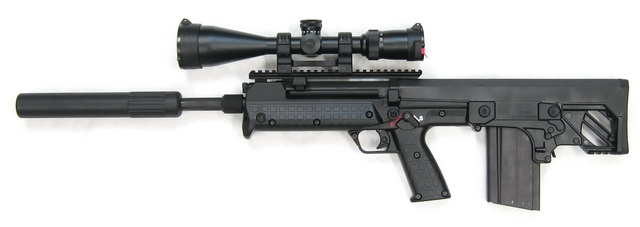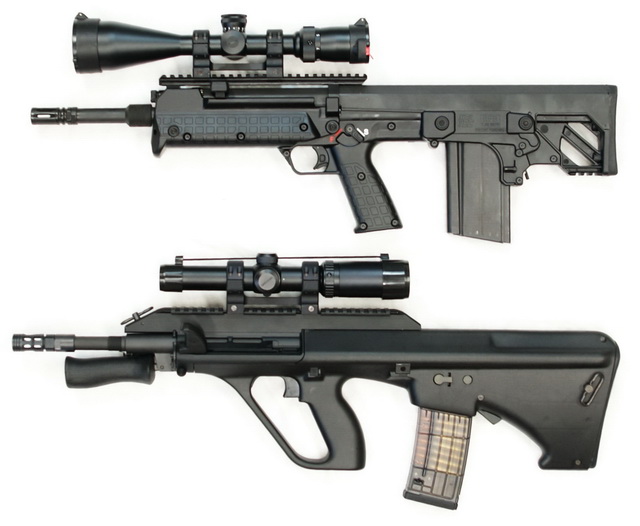In 2007 Kel-Tec announced they would produce a clever new .308 Rifle, Forward-ejecting, Bullpup style (RFB). It immediately hit the wish lists of gun enthusiasts across the country. Mine is shown here with a 3-15x50mm Nitrex scope and AAC Cyclone suppressor.
This gun has a number of commendable features:
- It weighs just over 8 pounds, yet fires the medium-size .308 cartridge
- It has an 18″ barrel yet measures just 26″ overall (the shortest allowed for an unregistered rifle)
- It has a crisp 6.5-pound trigger, proving that bullpups don’t have to have terrible triggers
- It uses standard FAL magazines, which are widely and cheaply available
- It ejects spent cases forward, making it a truly ambidextrous bullpup
The RFB does have a few shortcomings that I will touch on in the course of this review, most critically in its gas system design.
The Biggest Challenge: Getting one
As of 2011 Q1 Kel-Tec has produced only 1500 of these rifles. The MSRP of $1880 hasn’t changed since it was first announced. Kel-Tec is irritatingly detached from the market for its products: The company increases neither production rates nor prices in response to ongoing high demand. Furthermore, the company only sells its firearms through an inscrutable network of distributors. To this day none of my dealers have been able to get their hands on an RFB. Meanwhile, people who do acquire them have always been able to scalp them on GunBroker.com for hundreds of extra dollars. Kel-Tec, obliviously, sells these to its distributors for under $1200.
I finally obtained one by learning through their fan forum that a batch was shipping to a particular distributor who was willing to make a direct sale to me (transferring, of course, through an FFL). My final cost was just $1350 which is considered closer to the “fair” street price than the MSRP.
The Bullpup Advantage
I have been a longtime fan of the bullpup firearm design, which places the action and magazine behind the trigger. The benefits are pretty clear in the following picture showing the RFB (18″ bbl) next to a comparable conventional semi-auto rifle (the FNAR, 20″ bbl) and a traditional bolt-action sniper rifle (the Savage 10FP, 26″ bbl).
The reduced length alone makes a bullpup much more practical for enclosed or close-quarters use. What you may not realize until you handle one is that the center of mass is moved so far to the rear that it is easy to shoulder and shoot, if necessary, with just one hand.
Kel-Tec also adopted one of the latest innovations in bullpups (first seen on the bulbous FN F2000): forward ejection. This solves one of the traditional drawbacks of a bullpup rifle, which is that it ejects right next to the shooter’s head. Side-ejectors are difficult to shoot cross-shoulder (to shoot weak side you have to either hold the gun out from your shoulder or cup the ejection port with your support hand to avoid eating hot brass). The RFB is truly ambidextrous. Kel-Tec earns extra points for a particularly compact action: The following photo shows it is slightly shorter overall than a Steyr AUG, even though the AUG only has a 16″ barrel!
Shooting
While relatively crisp, the RFB trigger is still 6.5 pounds. This may have limited my ability to wring the full accuracy out of the gun during my first test session, during which I fired three different cartridges, with and without a suppressor. Kel-Tec only claims this is a “2MOA” gun, and that was the best I was able to shoot with factory match-grade 168gr cartridges.
I chronographed 168gr BTHPM at 2510fps, 150gr BTFMJ at 2570fps, and 125gr SP at 2965fps. Kel-Tec lists an effective range of 600m for this 18″ barrel. Based on my chronographs this is indeed about the distance when these rounds will go trans-sonic.
Shortcomings
Kel-Tec chose to cut their 18″ barrel with 1:11.25″ twist rifling, which is on the slow end of standard .308 twist rates. This is not the best choice for the slower muzzle velocities produced by this short barrel, and it limits the ability of this gun to shoot the heavier and longer .30″ bullets on the market. 1:10″ would be a more logical twist rate. 1:8″, though not yet common in this caliber, would not only guarantee stability across the full range of .30″ bullets, but also would allow the gun to accurately shoot subsonic ammunition.
I found the pistol grip to be another shortcoming. It is made of a relatively slippery plastic and is not replaceable. Kel-Tec should have designed this rifle for compatibility with the vast market of modular AR-15-pattern grips, allowing owners to find a size and finish that suits their hands.
Design Flaw
The RFB gas system — the core of any self-loading rifle’s operation — has some serious design flaws. Kel-Tec seems to have developed theirs without any regard to the state of the art in piston-driven rifles. As a result their rifle is currently not suited to use with suppressors.
The RFB gas block is a simple T with fixed channel sizes allowing gas to flow through a forward exhaust port and backwards through the piston. The only means of controlling gas pressure on the action is to turn a “Gas Adjust” valve that changes the proportion of gas that can exhaust through the forward port, but that doesn’t restrict total flow through the gas block. This is the biggest design flaw in the gas system, and it makes this gun unsuitable for use with a suppressor: Suppressors boost total pressure on the gas system. Modern pistons offer a “Silencer” setting that compensates for elevated backpressure by severely choking flow through the gas block. Since the RFB can’t reduce the flow of gas from the barrel the manual instructs users to remove the “Gas Adjust” valve in order to maximize the ability of the extra pressure to vent out the forward port. This is exactly not what you want to do when shooting with a suppressor: The high-pressure gas venting out of the gas block is not contained by the silencer and so it creates its own loud report.
In theory Kel-Tec could correct this problem by replacing their “Gas Adjust” valve with a conventional “Gas Select” valve: A dial that extends across the barrel port in the gas block, completely obstructing the flow of gas. The circumference of a Gas Select valve is drilled with holes of varying diameter, typically offering four settings:
- Off: No gas is allowed to impinge on the piston, making the firearm shoot like a single-shot “bolt” gun. This setting is great for testing accuracy and for minimizing noise when shooting suppressed.
- Suppressed: The smallest hole allows the action to cycle under the extended backpressure created by a suppressor.
- Normal: This is a hole large enough to cycle the action under regular conditions.
- Boost: The largest hole provides extra gas pressure to cycle the action, compensating for underpowered ammunition or extremely dirty or cold conditions.
I.e., a proper “Gas Select” valve turns Kel-Tec’s “T” gas head into an “L” so that 100% of the gas tapped from the barrel impinges on the piston.
This takes us to the other gas design flaw: The RFB piston allows impinging gas to flow past its head when it cycles. The problem with this is that the piston vents into the carrier channel where the propellant gases then flow through the entire gun, coating everything in hot carbon. One of the key benefits of piston actions is supposed to be the isolation of propellant from the receiver. But in the RFB even the bolt at the extreme rear of the gun gets as dirty as the old direct-impingement AR-15 bolts I swore off years ago.
Kel-Tec needs to redesign the RFB piston to vent its gas outside and away from the receiver.



An Interview with Matt at Kel-Tec on the RFB.
I am curious as to your thoughts on the AUG A3’s gas select system? Looking at my own, it does not seem to capture 100% of the gas on any single setting. Twisting it will simply vary how much gas is vented from the gas chamber to the right of the barrel to the outside of the gun. Normal setting makes a medium-sized hole visible for venting, the second setting makes a small hole visible for venting,(building up higher pressures in the gas chamber) and grenade makes a significantly larger hole visible on the underside. Also take note of the fact that there is a hole drilled further back into the piston-cylinder assembly, which only becomes exposed to the gases when the piston has cycled all the way back. (Presumably to release pressure once the piston has cycled far enough back to have done it’s job.) Do you think that this renders the AUG A3 unsuitable for suppression?
Apt observation: None of the “gas select” valves I have seen completely contain the propellant gas used to cycle the action; whatever gas drives the piston is ultimately vented somewhere at sufficient pressure to make noise. To deal with that people have suggested “gas port shrouds” or various other means of plumbing the gas system into a mounted suppressor. In practice that’s unnecessary: A “good” gas select system with a silencer setting vents the minimum pressure needed to operate the action, and in my experience that makes less noise than a full-power rifle cartridge blowing through even a good baffle suppressor. (Look for articles on subsonic rifle cartridges in the next few months and we’ll see if that still holds once the sonic crack is removed from the mix.)
As for the AUG: You are right, it appears to suffer a design flaw similar to the RFB’s: It taps a constant amount of gas from the barrel and the valve serves only to change the proportion sent rearward instead of vented directly before the piston. To be fair, this is a 30-year-old design. It doesn’t even have a proper “silencer” setting, which would be something like 1/3 the size of the “normal” gas port. (Why MSAR didn’t update this on their clones, especially given that they intended to develop a silencer of their own, is another mystery.)
Examples of “good” gas systems can be seen on the Ruger SR-556 and the XCR.
These comments are a year old. I’m receiving shipment of my new RFB this week. Any new news, views, or reveiws?
Congratulations!
I’d check out this forum at theKTOG.org to get the latest news and views on the RFB.
Supply update: As of mid-2012 it appears Kel-Tec has only produced 3000 of these!
Kel Tec recently added a huge new building to their facility, lets hope this get them pumping out a few more of these bad boys so I don’t have to turn to gunbroker for a massively over priced one.
Pingback: EmptorMaven » Blog Archive » CQB Rifle Optics
Had my RFB for 2 years and it’s an excellent weapon, no jams, hard hitting at 800mm, and a great close quaters weapon…..
I’ve found the RFB to jam frequently; it is very sensitive to the ammunition and the gas setting.